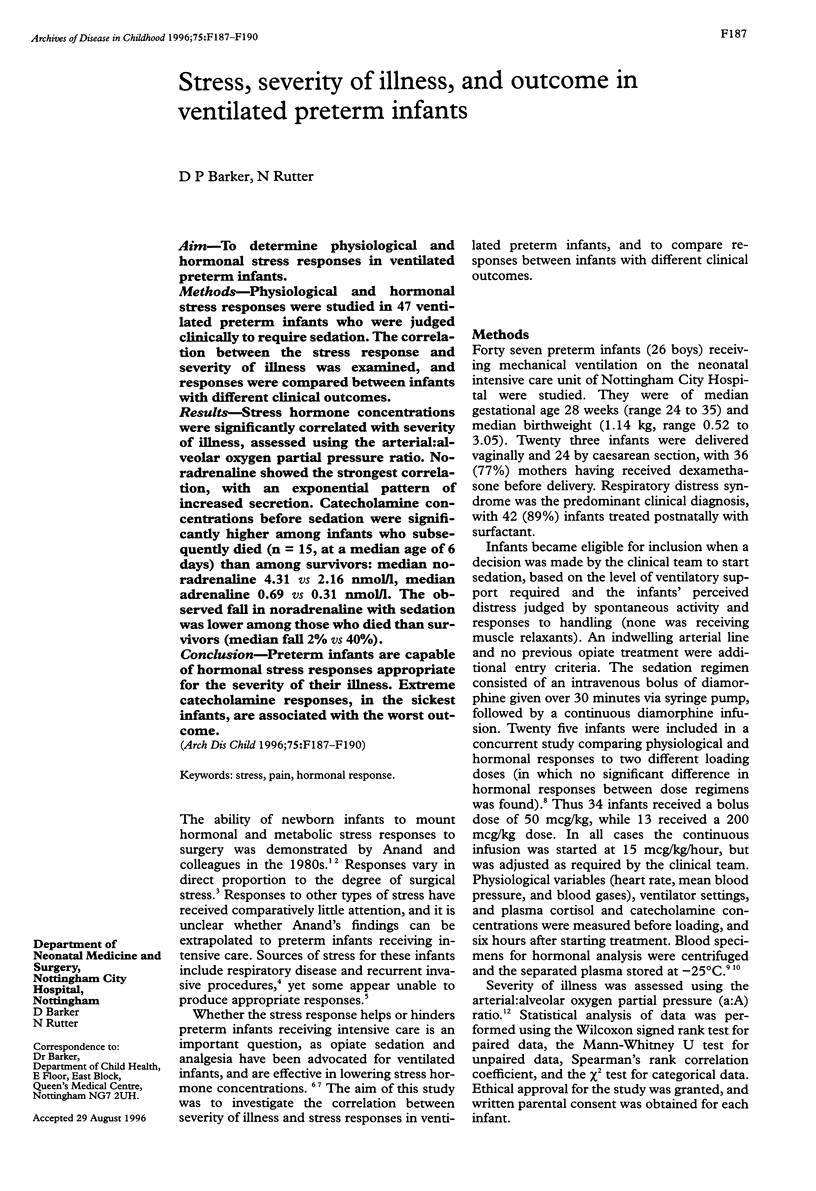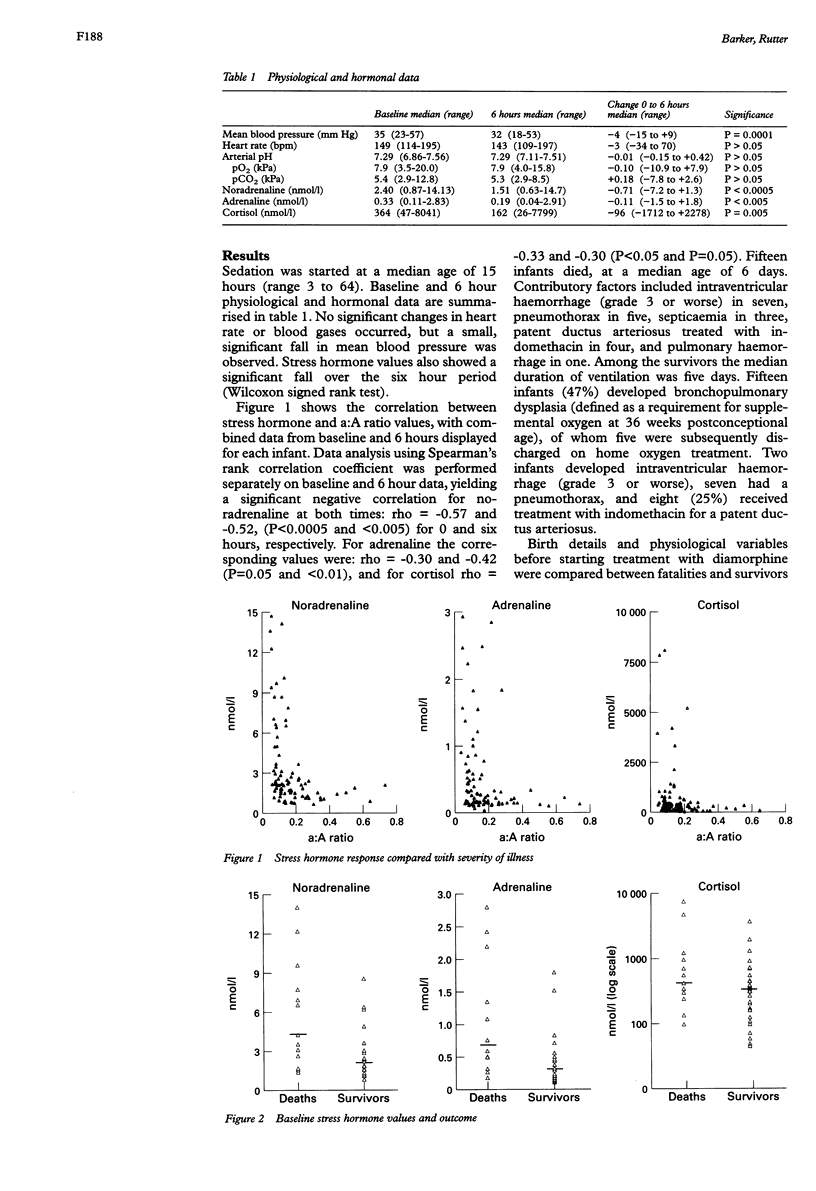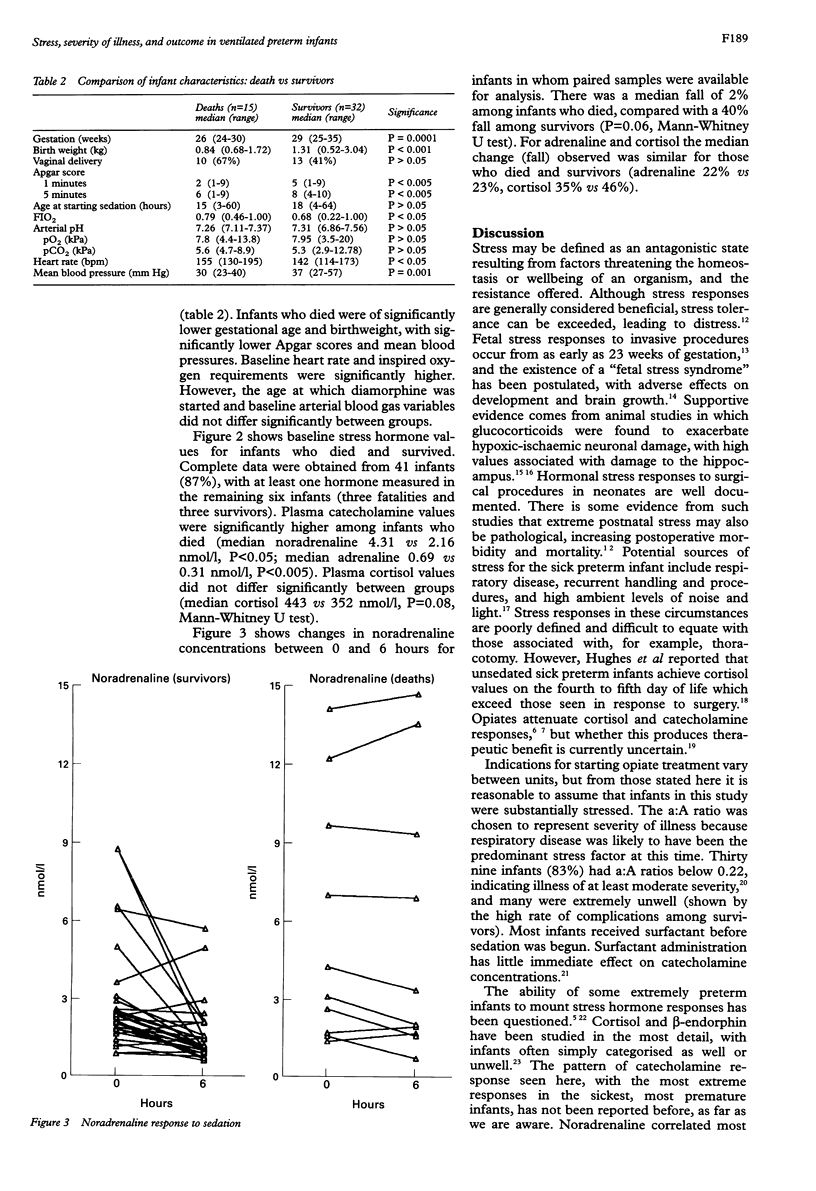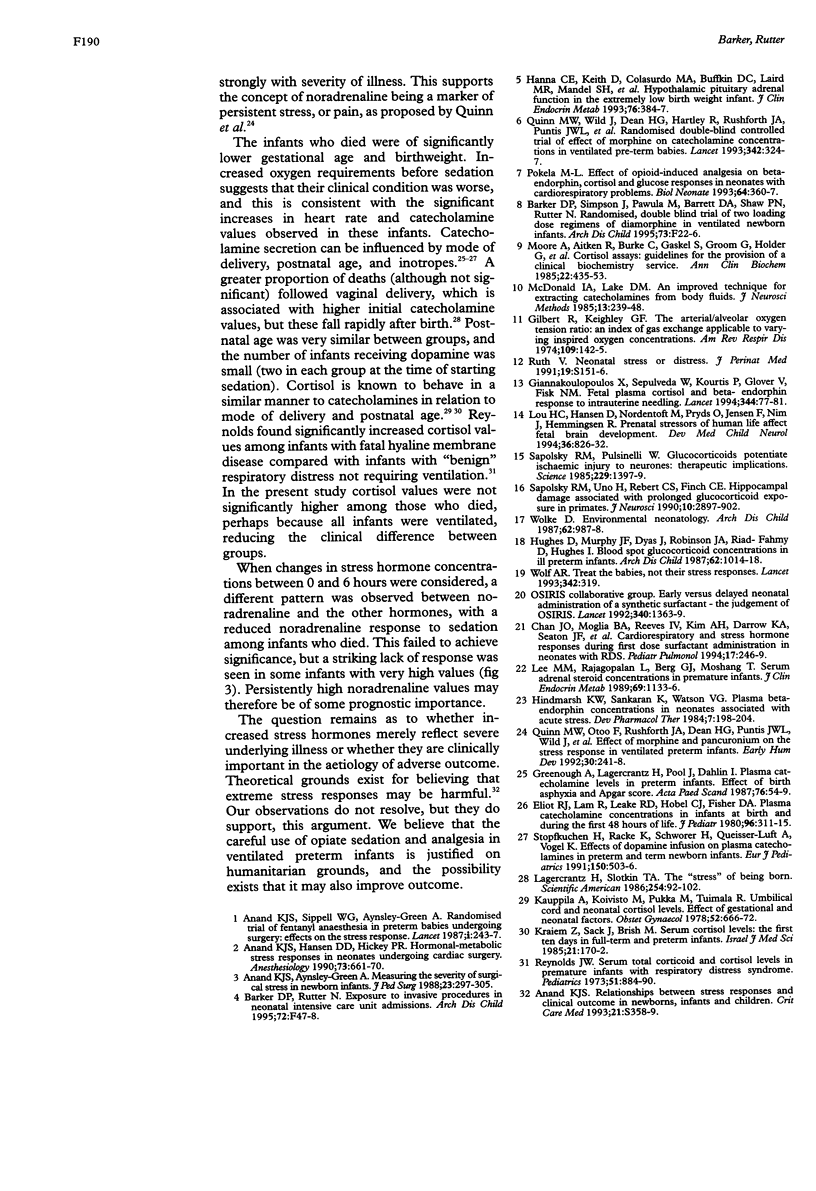Abstract
AIM: To determine physiological and hormonal stress responses in ventilated preterm infants. METHODS: Physiological and hormonal stress responses were studied in 47 ventilated preterm infants who were judged clinically to require sedation. The correlation between the stress response and severity of illness was examined, and responses were compared between infants with different clinical outcomes. RESULTS: Stress hormone concentrations were significantly correlated with severity of illness, assessed using the arterial: alveolar oxygen partial pressure ratio. Noradrenaline showed the strongest correlation, with an exponential pattern of increased secretion. Catecholamine concentrations before sedation were significantly higher among infants who subsequently died (n = 15, at a median age of 6 days) than among survivors: median noradrenaline 4.31 vs 2.16 nmol/l, median adrenaline 0.69 vs 0.31 nmol/l. The observed fall in noradrenaline with sedation was lower among those who died than survivors (median fall 2% vs 40%). CONCLUSION: Preterm infants are capable of hormonal stress responses appropriate for the severity of their illness. Extreme catecholamine responses, in the sickest infants, are associated with the worst outcome.
Full text
PDF



Selected References
These references are in PubMed. This may not be the complete list of references from this article.
- Anand K. J., Aynsley-Green A. Measuring the severity of surgical stress in newborn infants. J Pediatr Surg. 1988 Apr;23(4):297–305. doi: 10.1016/s0022-3468(88)80193-3. [DOI] [PubMed] [Google Scholar]
- Anand K. J., Hansen D. D., Hickey P. R. Hormonal-metabolic stress responses in neonates undergoing cardiac surgery. Anesthesiology. 1990 Oct;73(4):661–670. doi: 10.1097/00000542-199010000-00012. [DOI] [PubMed] [Google Scholar]
- Anand K. S. Relationships between stress responses and clinical outcome in newborns, infants, and children. Crit Care Med. 1993 Sep;21(9 Suppl):S358–S359. doi: 10.1097/00003246-199309001-00035. [DOI] [PubMed] [Google Scholar]
- Barker D. P., Simpson J., Pawula M., Barrett D. A., Shaw P. N., Rutter N. Randomised, double blind trial of two loading dose regimens of diamorphine in ventilated newborn infants. Arch Dis Child Fetal Neonatal Ed. 1995 Jul;73(1):F22–F26. doi: 10.1136/fn.73.1.f22. [DOI] [PMC free article] [PubMed] [Google Scholar]
- Chan J. O., Moglia B. A., Reeves I. V., Kim A. H., Darrow K. A., Seaton J. F., Marks K. H. Cardiorespiratory and stress hormone responses during first dose surfactant administration in neonates with RDS. Pediatr Pulmonol. 1994 Apr;17(4):246–249. doi: 10.1002/ppul.1950170408. [DOI] [PubMed] [Google Scholar]
- Eliot R. J., Lam R., Leake R. D., Hobel C. J., Fisher D. A. Plasma catecholamine concentrations in infants at birth and during the first 48 hours of life. J Pediatr. 1980 Feb;96(2):311–315. doi: 10.1016/s0022-3476(80)80836-5. [DOI] [PubMed] [Google Scholar]
- Giannakoulopoulos X., Sepulveda W., Kourtis P., Glover V., Fisk N. M. Fetal plasma cortisol and beta-endorphin response to intrauterine needling. Lancet. 1994 Jul 9;344(8915):77–81. doi: 10.1016/s0140-6736(94)91279-3. [DOI] [PubMed] [Google Scholar]
- Gilbert R., Keighley J. F. The arterial-alveolar oxygen tension ratio. An index of gas exchange applicable to varying inspired oxygen concentrations. Am Rev Respir Dis. 1974 Jan;109(1):142–145. doi: 10.1164/arrd.1974.109.1.142. [DOI] [PubMed] [Google Scholar]
- Greenough A., Lagercrantz H., Pool J., Dahlin I. Plasma catecholamine levels in preterm infants. Effect of birth asphyxia and Apgar score. Acta Paediatr Scand. 1987 Jan;76(1):54–59. doi: 10.1111/j.1651-2227.1987.tb10414.x. [DOI] [PubMed] [Google Scholar]
- Hindmarsh K. W., Sankaran K., Watson V. G. Plasma beta-endorphin concentrations in neonates associated with acute stress. Dev Pharmacol Ther. 1984;7(3):198–204. doi: 10.1159/000457163. [DOI] [PubMed] [Google Scholar]
- Hughes D., Murphy J. F., Dyas J., Robinson J. A., Riad-Fahmy D., Hughes I. A. Blood spot glucocorticoid concentrations in ill preterm infants. Arch Dis Child. 1987 Oct;62(10):1014–1018. doi: 10.1136/adc.62.10.1014. [DOI] [PMC free article] [PubMed] [Google Scholar]
- Kauppila A., Koivisto M., Pukka M., Tuimala R. Umbilical cord and neonatal cortisol levels. Effect of gestational and neonatal factors. Obstet Gynecol. 1978 Dec;52(6):666–672. [PubMed] [Google Scholar]
- Kraiem Z., Sack J., Brish M. Serum cortisol levels: the first 10 days in full-term and preterm infants. Isr J Med Sci. 1985 Feb;21(2):170–172. [PubMed] [Google Scholar]
- Lee M. M., Rajagopalan L., Berg G. J., Moshang T., Jr Serum adrenal steroid concentrations in premature infants. J Clin Endocrinol Metab. 1989 Dec;69(6):1133–1136. doi: 10.1210/jcem-69-6-1133. [DOI] [PubMed] [Google Scholar]
- Lou H. C., Hansen D., Nordentoft M., Pryds O., Jensen F., Nim J., Hemmingsen R. Prenatal stressors of human life affect fetal brain development. Dev Med Child Neurol. 1994 Sep;36(9):826–832. doi: 10.1111/j.1469-8749.1994.tb08192.x. [DOI] [PubMed] [Google Scholar]
- Macdonald I. A., Lake D. M. An improved technique for extracting catecholamines from body fluids. J Neurosci Methods. 1985 May;13(3-4):239–248. doi: 10.1016/0165-0270(85)90072-x. [DOI] [PubMed] [Google Scholar]
- Moore A., Aitken R., Burke C., Gaskell S., Groom G., Holder G., Selby C., Wood P. Cortisol assays: guidelines for the provision of a clinical biochemistry service. Ann Clin Biochem. 1985 Sep;22(Pt 5):435–454. doi: 10.1177/000456328502200501. [DOI] [PubMed] [Google Scholar]
- Pokela M. L. Effect of opioid-induced analgesia on beta-endorphin, cortisol and glucose responses in neonates with cardiorespiratory problems. Biol Neonate. 1993;64(6):360–367. doi: 10.1159/000244012. [DOI] [PubMed] [Google Scholar]
- Quinn M. W., Otoo F., Rushforth J. A., Dean H. G., Puntis J. W., Wild J., Levene M. I. Effect of morphine and pancuronium on the stress response in ventilated preterm infants. Early Hum Dev. 1992 Oct;30(3):241–248. doi: 10.1016/0378-3782(92)90073-p. [DOI] [PubMed] [Google Scholar]
- Quinn M. W., Wild J., Dean H. G., Hartley R., Rushforth J. A., Puntis J. W., Levene M. I. Randomised double-blind controlled trial of effect of morphine on catecholamine concentrations in ventilated pre-term babies. Lancet. 1993 Aug 7;342(8867):324–327. doi: 10.1016/0140-6736(93)91472-x. [DOI] [PubMed] [Google Scholar]
- Reynolds J. W. Serum total corticoid and cortisol levels in premature infants with respiratory distress syndrome. Pediatrics. 1973 May;51(5):884–890. [PubMed] [Google Scholar]
- Sapolsky R. M., Pulsinelli W. A. Glucocorticoids potentiate ischemic injury to neurons: therapeutic implications. Science. 1985 Sep 27;229(4720):1397–1400. doi: 10.1126/science.4035356. [DOI] [PubMed] [Google Scholar]
- Sapolsky R. M., Uno H., Rebert C. S., Finch C. E. Hippocampal damage associated with prolonged glucocorticoid exposure in primates. J Neurosci. 1990 Sep;10(9):2897–2902. doi: 10.1523/JNEUROSCI.10-09-02897.1990. [DOI] [PMC free article] [PubMed] [Google Scholar]
- Stopfkuchen H., Racké K., Schwörer H., Queisser-Luft A., Vogel K. Effects of dopamine infusion on plasma catecholamines in preterm and term newborn infants. Eur J Pediatr. 1991 May;150(7):503–506. doi: 10.1007/BF01958433. [DOI] [PubMed] [Google Scholar]
- Wolf A. R. Treat the babies, not their stress responses. Lancet. 1993 Aug 7;342(8867):319–320. doi: 10.1016/0140-6736(93)91468-2. [DOI] [PubMed] [Google Scholar]
- Wolke D. Environmental neonatology. Arch Dis Child. 1987 Oct;62(10):987–988. doi: 10.1136/adc.62.10.987. [DOI] [PMC free article] [PubMed] [Google Scholar]


